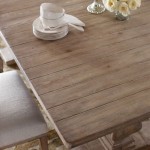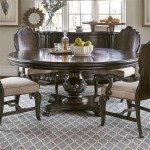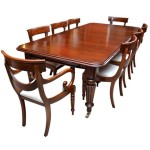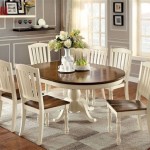Ideas For Painting Dining Room Table And Chairs
Choosing to paint a dining room table and chairs offers a cost-effective and transformative way to refresh a dining space. Instead of purchasing a new set, painting allows for personalization and the creation of a unique focal point within the room. The process, while straightforward, requires careful consideration of various factors, including the existing style of the furniture, the desired aesthetic, and the durability of the finish. The ultimate goal is to achieve a beautiful and functional set that complements the overall décor of the dining area.
This article explores a variety of ideas for painting dining room tables and chairs, focusing on different styles, techniques, and color palettes. It aims to provide a comprehensive guide to help homeowners and designers make informed decisions and achieve professional-looking results when undertaking this project.
Selecting the Right Paint Type and Finish
The selection of paint is paramount to the success and longevity of any furniture painting project. Different paint types offer varying levels of durability, ease of application, and aesthetic appeal. Understanding the characteristics of each type allows for an informed decision that aligns with the intended use and desired finish.
Latex Paint: Latex paint is a popular choice due to its affordability, ease of use, and low odor. It is water-based, making it easy to clean up with soap and water. Latex paint is available in a wide range of colors and finishes, from matte to semi-gloss. While latex paint is generally durable, it may require multiple coats for optimal coverage, especially when painting over dark surfaces. It is also recommended to apply a primer before painting with latex, particularly on bare wood or glossy surfaces, to ensure proper adhesion.
Oil-Based Paint: Oil-based paint is known for its durability and smooth, hard finish. It is resistant to chipping, scratching, and staining, making it a good choice for dining room furniture that will experience frequent use. However, oil-based paint has a strong odor and requires mineral spirits for cleanup. It also takes longer to dry than latex paint. Due to its higher VOC (volatile organic compounds) content, oil-based paint may not be compliant with environmental regulations in some areas. Furthermore, oil-based paints yellow over time, especially lighter colors, which should be considered.
Chalk Paint: Chalk paint has become a popular choice for furniture painting, especially for achieving a distressed or vintage look. It adheres well to most surfaces without requiring extensive sanding or priming, making it a convenient option. Chalk paint dries quickly and has a matte finish that can be easily distressed. It is typically sealed with wax or a clear coat to protect the finish and provide durability. However, chalk paint is generally more expensive than latex paint, and the wax finish may require occasional maintenance.
Acrylic Paint: Acrylic paint is a versatile option that offers good durability and color retention. It is water-based, easy to clean up, and available in a wide range of colors and finishes. Acrylic paint is suitable for both indoor and outdoor use. It dries quickly and forms a durable, flexible film that is resistant to cracking and peeling. Acrylic paint is a good choice for painting dining room furniture that will be exposed to moisture or temperature fluctuations.
Paint Finishes: The paint finish affects the appearance and durability of the painted furniture. Matte finishes have a low sheen and hide imperfections well, but they are less durable and harder to clean. Eggshell finishes have a slightly higher sheen and offer better durability and cleanability. Satin finishes are more durable and easier to clean than eggshell finishes, with a moderate sheen. Semi-gloss finishes are highly durable and easy to clean, making them a good choice for surfaces that require frequent cleaning. Gloss finishes have the highest sheen and are the most durable and easiest to clean, but they can highlight imperfections.
Ultimately, the choice of paint type and finish depends on the specific needs and preferences of the project. Considerations should include the desired aesthetic, the level of durability required, the ease of application, and the environmental impact of the paint.
Color Palette and Design Considerations
Selecting the color palette and overall design is a critical step in painting dining room tables and chairs. The chosen colors should complement the existing décor of the dining room and create the desired atmosphere. The design should also be functional and reflect the homeowner's personal style.
Complementary Colors: Complementary colors are pairs of colors that are opposite each other on the color wheel, such as blue and orange, red and green, or yellow and purple. Using complementary colors can create a vibrant and visually appealing contrast in the dining room. For example, a blue dining room can be complemented by painting the chairs in orange or yellow. This approach can add a sense of energy and excitement to the space.
Monochromatic Colors: A monochromatic color scheme involves using different shades and tints of a single color. This approach can create a calming and sophisticated atmosphere in the dining room. For example, using different shades of gray or beige can create a neutral and elegant backdrop for dining. Accenting with textures and materials can prevent the monochromatic palette from becoming monotonous.
Analogous Colors: Analogous colors are colors that are adjacent to each other on the color wheel, such as blue, green, and turquoise. Using analogous colors can create a harmonious and relaxing atmosphere in the dining room. For example, painting the table in a shade of green and the chairs in shades of blue can create a sense of tranquility and connection to nature.
Two-Toned Design: A two-toned design involves using two contrasting colors to create visual interest. This approach can be particularly effective for dining room chairs. For example, painting the chair frames in one color and the seats in another can add a touch of whimsy and personality to the dining room. Consider painting the table base a different color than the tabletop for a striking effect.
Distressed Finish: A distressed finish involves intentionally creating an aged or weathered look on the furniture. This can be achieved by sanding away some of the paint to reveal the underlying wood or by using special distressing techniques. A distressed finish can add character and charm to the dining room, especially in a farmhouse or rustic-style setting. Chalk paint is particularly well-suited for achieving a distressed look.
Stenciled Designs: Stenciling involves using stencils to apply decorative patterns to the furniture. This can be a great way to add a personal touch to the dining room. Stencils can be used to create a variety of patterns, from simple geometric designs to intricate floral motifs. Stenciled designs can be particularly effective on chair backs or table tops.
Ombre Effect: The ombre effect involves gradually blending one color into another. This can be achieved by painting the furniture in a range of shades, from light to dark. An ombre effect can add depth and dimension to the dining room. Consider creating an ombre effect on the chair legs, gradually transitioning from a lighter shade at the top to a darker shade at the bottom.
When selecting the color palette and design, it is important to consider the existing décor of the dining room. The painted furniture should complement the walls, flooring, and other furnishings in the room. It is also important to consider the size and shape of the dining room table and chairs. Larger pieces of furniture can handle bolder colors and designs, while smaller pieces may benefit from more subtle treatments. Test paint colors in the actual lighting of the dining room before committing to a final decision. Lighting can significantly impact how colors appear.
Preparation and Painting Techniques
Proper preparation and application techniques are essential for achieving a professional-looking finish when painting dining room tables and chairs. Careful attention to detail during each step of the process will ensure that the paint adheres properly and the finished product is durable and aesthetically pleasing.
Surface Preparation: The first step in painting dining room furniture is to prepare the surface. This involves cleaning the furniture to remove any dirt, grease, or wax. Use a mild detergent and water to clean the furniture, and then rinse it thoroughly. If the furniture has a glossy finish, it may need to be sanded to create a better surface for the paint to adhere to. Use a fine-grit sandpaper to lightly sand the furniture, and then wipe it down with a tack cloth to remove any sanding dust. If the furniture has any existing chipped or peeling paint, it should be removed before painting. A paint scraper or chemical stripper can be used to remove old paint.
Priming: Priming is an important step in painting dining room furniture, especially if the furniture is made of bare wood or has a dark finish. Primer helps to seal the surface, prevent the paint from soaking into the wood, and provide a better surface for the paint to adhere to. Apply a thin, even coat of primer to the furniture, and allow it to dry completely before painting. Choose a primer that is compatible with the type of paint being used.
Painting: When painting dining room furniture, it is important to use high-quality paint and brushes. Apply the paint in thin, even coats, and allow each coat to dry completely before applying the next. Use a brush or roller to apply the paint, depending on the size and shape of the furniture. For intricate details, use a small brush to apply the paint. Avoid applying too much paint at once, as this can lead to drips and runs. If drips or runs do occur, use a brush to smooth them out before the paint dries.
Sanding Between Coats: Lightly sanding between coats of paint can help to create a smoother finish. Use a fine-grit sandpaper to lightly sand the furniture after each coat of paint has dried. This will remove any imperfections and create a better surface for the next coat of paint to adhere to. Wipe the furniture down with a tack cloth to remove any sanding dust before applying the next coat of paint.
Sealing: Sealing the painted furniture is important to protect the finish and make it more durable. A clear coat of polyurethane or varnish can be used to seal the furniture. Apply a thin, even coat of sealant to the furniture, and allow it to dry completely before using the furniture. Choose a sealant that is compatible with the type of paint being used.
Spray Painting: Spray painting is an alternative to using brushes and rollers. It can be a faster and more efficient way to paint dining room furniture, especially for pieces with intricate details. However, spray painting requires more preparation and skill than brushing or rolling. It is important to use a spray booth or work in a well-ventilated area to avoid inhaling paint fumes. Mask off any areas that should not be painted, and use a primer to prepare the surface. Apply the paint in thin, even coats, and allow each coat to dry completely before applying the next.
Drying Time: Allow the painted furniture to dry completely before using it. The drying time will vary depending on the type of paint and sealant used. Follow the manufacturer's instructions for drying time. Avoid placing heavy objects on the painted furniture until it is fully dry.
By following these preparation and painting techniques, homeowners can achieve a professional-looking finish on their dining room tables and chairs. Careful attention to detail and patience are key to success.

The Best Way To Paint A Dining Table And Chairs Confessions Of Serial Do It Yourselfer

Dining Room Table Makeover Sew Crafty Crochet

7 Paint Ideas To Transform A Dining Table Eatwell101

Table And Chairs Makeover With Chalk Style Paint I Should Be Mopping The Floor

Dining Table Makeover Take One Confessions Of A Serial Do It Yourselfer

How To Save Tired Dining Room Chairs With Chalk Paint Right Now

Kitchen Table Makeover With Chalky Finish Paint Kelly Leigh Creates

Painted Dining Room Set Giving Old Furniture New Life

How To Paint A Vintage Dining Table Bluesky At Home

How To Paint Dining Chairs Get Professional Results The Homes I Have Made








